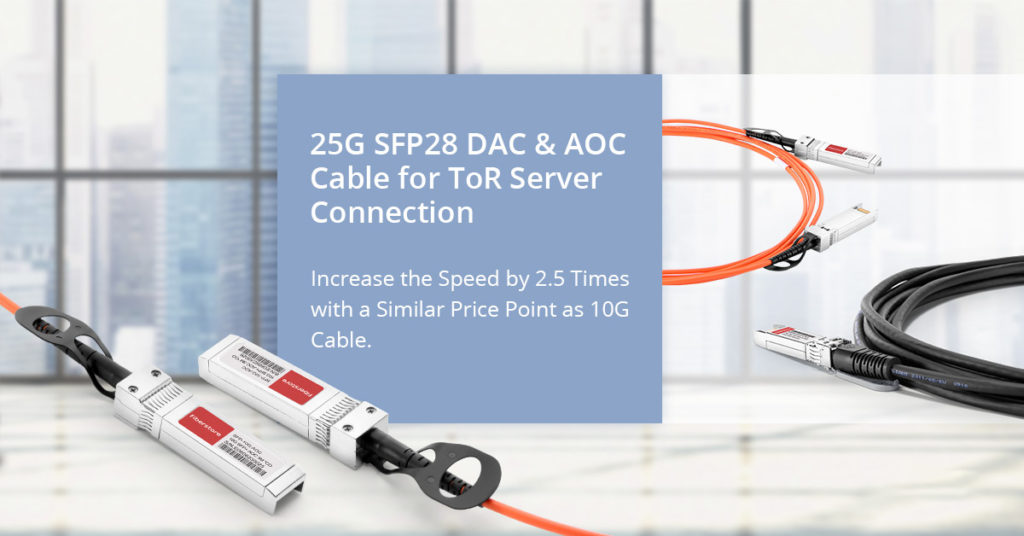In recent years, data centers are expanding at an unprecedented pace to drive the need for increasing bandwidth between the server and switches. 10GbE is not adequate bandwidth for today’s networks. There’s a tendency that 25GbE (based on SFP28) is on route to displace 10GbE (based on SFP+) from its leading role as the work horse in networking construction. As this transition takes place, questions about SFP+ and SFP28 compatibility arise for anyone who’s planning to upgrade the 10GbE to the higher and faster 25GbE. This post will provide a thorough presentation to 25GbE and clarify the compatibility issues between 10G SFP+ and 25G SFP28.
What Is 25G and Why Do We Need It?
25G Ethernet was based on the IEEE 802.3by standard and released in 2016. 25GbE specification makes use of single-lane 25 Gbps Ethernet links, providing a simpler path to future Ethernet speeds of 50 Gbps, 100 Gbps and beyond. By offering the advantages listed below, 25GbE is gained more and more momentum among service providers and data centers.
The high performance 25G chips use single-lane 25G serdes technology similar in operation to 10GbE, supporting technology advancements from 10G in packaging and silicon. 25GbE allows existing switch architectures to support link speeds faster than 10G with no increase in cable/ trace interconnect.
The 25G Ethernet based on the SFP28 form factor delivers 2.5 times more performance and bandwidth compared to 10G speeds. It also provides easy migration path to 50GE (2x25GE) & 100GE (4x25G), laying a path to higher networking speeds like 200G and 400G.
25GbE delivers 2.5 times more data vs. 10GbE, thus reducing the power and cost per gigabit significantly. This power savings will in turn result in lower cooling requirements and operational expenditure for data center operators.
Available 25G Optical Modules and Cables
Every new Ethernet speed has gone through multiple pluggable form factor migrations to achieve higher density and lower power consumption goals. For instance, 10G moved successively to the X2 and XFP form factors before finally converging on the SFP+ form factor that allows for up to 48 ports per 1U. Similar form factor transitions happened for 40G (CFP to QSFP) and 100G (CFP, CFP2, CFP4 and QSFP), in achieving the highest density and lowest power. With the release of the 25GbE specification, 25 Gigabit Ethernet equipment is available on the market using the SFP28 form factors. For optical modules, FS offers cost-effective 25GBASE-SR, 25GBASE-LR, and 25G CWDM SFP28 transceivers to cut your hardware costs. For short-haul transmission, 25G SFP28 DAC (direct attach cable) and 100G QSFP28 to 4x SFP28 AOC (active optical cable) in various lengths are also available for all needs and specifications.

10G SFP+ and 25G SFP28 Compatibility
With 10G and 25G Ethernet equipment coexisting on the market today, we may frequently encounter the compatibility issues related to SFP+ and SFP28 form factors. Anyway, the newer 25GbE technologies are backward compatible with 10GbE, allowing customers to build and cross-connect a heterogeneous-speed Ethernet network. Here we list the frequently asked questions coming through average customers.
The pinouts of SFP28 and SFP+ connectors are mating compatible. However, SFP+ is designed to operate at speed up to 10 Gb/s whereas SFP28 can handle 25Gbps, 10Gbps and even 1Gbps. SFP28 has increased bandwidth, superior impedance control and less crosstalk than the SFP+ solution. Besides, the SFP28 copper cable has significantly greater bandwidth and lower loss compared to the SFP+ version.
Theoretically, plugging an SFP28 transceiver or cable into the 10G interface is feasible for certain devices to get 10Gb/s data rate, but this solution is not recommended, because it would be limited by the NIC and switch port that you have. Only when your SFP28 module is 100% compatible with your server or switch can you ensure that the links can go seamlessly and efficiently.
Theoretically, plugging an SFP+ transceiver or cable into the 25G SFP28 slot is feasible. But you also need to make sure ensure that your existing modules will be compatible with your switch gear. That is to say, although a switch that accepts the SFP28 form factor can physically accept a SFP+ connector in the same port, it doesn’t mean that your SFP+ modules will work on your equipment.
Note: When shopping for new 25G leaf switches, if you have SFP+ modules you want to use, look for switches that accept the SFP28 form factor, which is physically capable of taking existing SFP+ modules. The same holds true for QSFP+ modules and QSFP28 ports. Carefully read the product specs to ensure that your existing modules will work with your new equipment.
Conclusion
As the majority of 25G switches and network interface cards offer backward compatibility to 10G, there is lots of flexibility to manage a gradual migration to higher speed servers and mix and match port speeds. Theoretically, all SFP28 based 25G ports on switches and 25G NICs can be used at 10G speed via port self-negotiation, but the premise should be that your existing modules are compatible with the NIC and switch port that you have. With a minimal premium for 25G based systems compared to 10G systems, it becomes a wise choice to deploy 25G capable systems to realize the performance advantages for migrations & future proofing initiatives.
Related Article:
10G – 25G – 100G Network Upgrade: An Inevitable Roadmap for Future Data Centers
FS 25G Portfolio for Data Center 25G/100G Leaf-Spine Network
